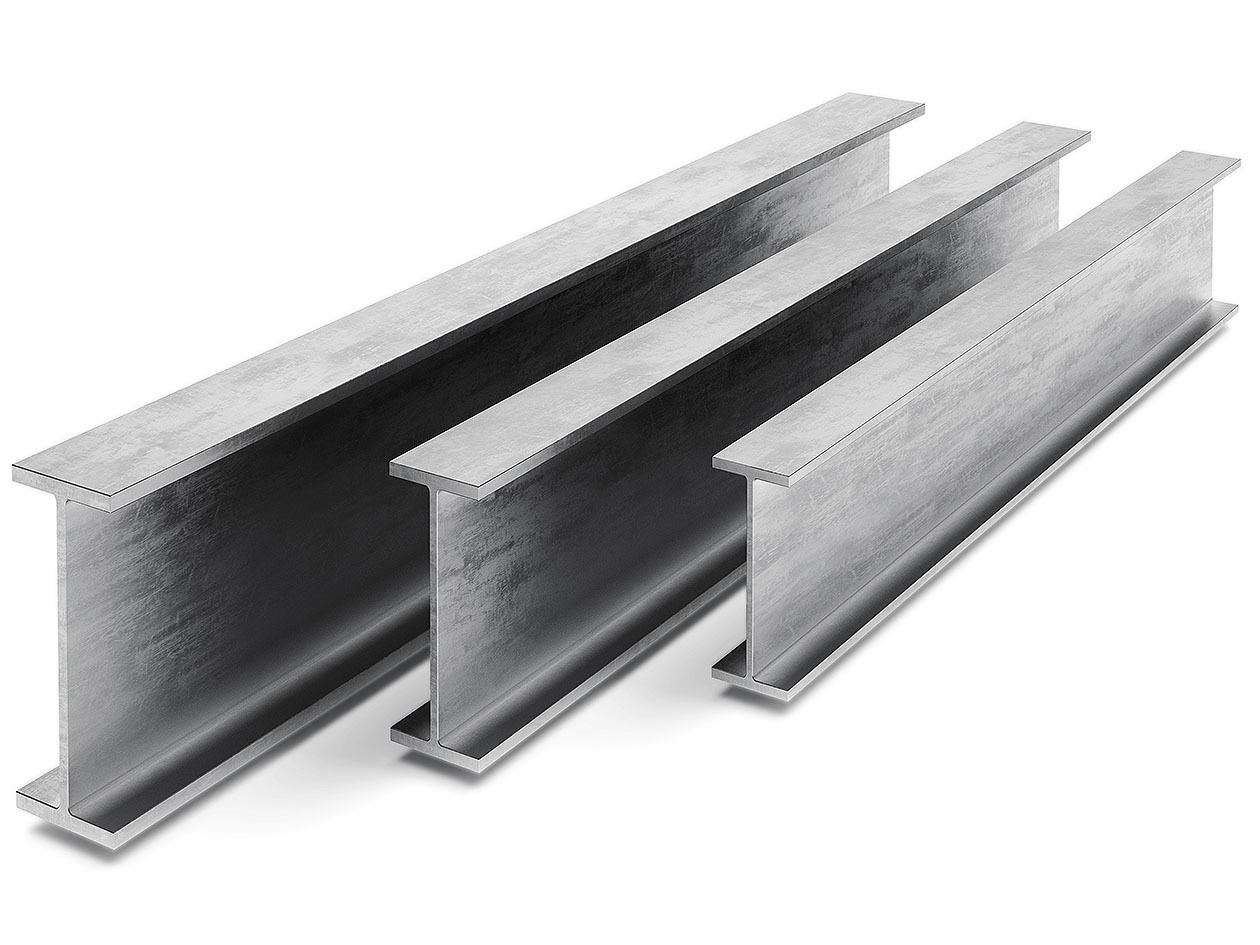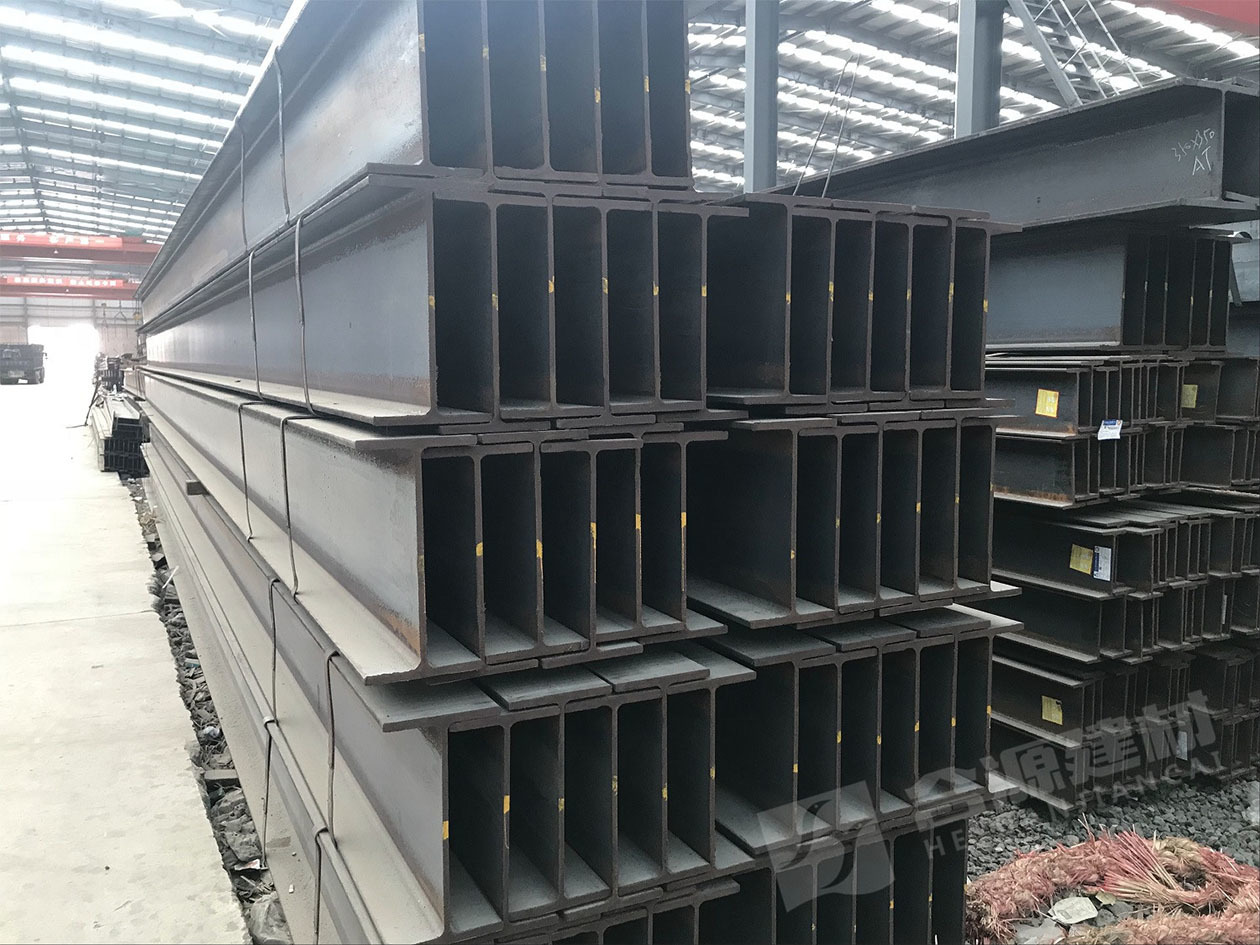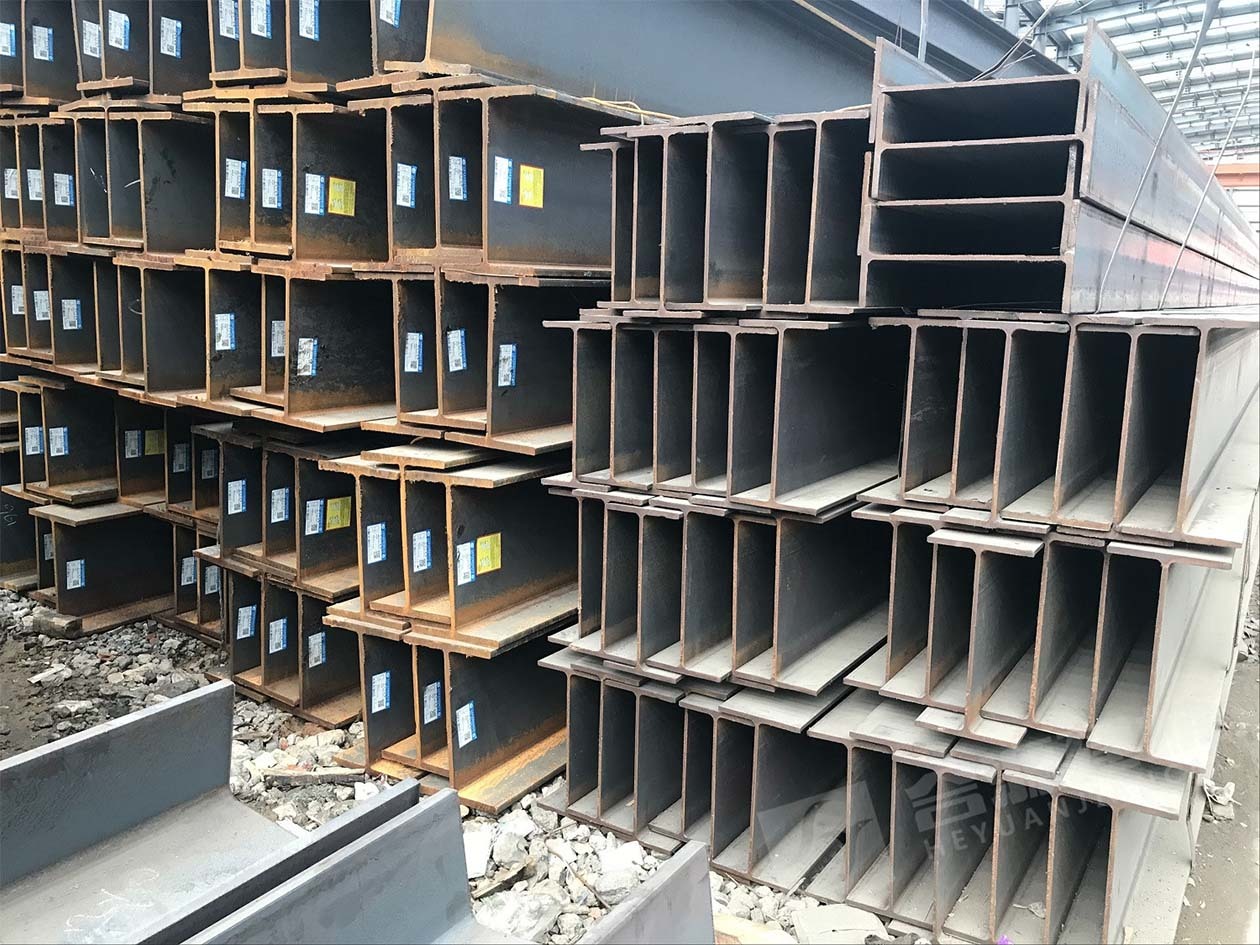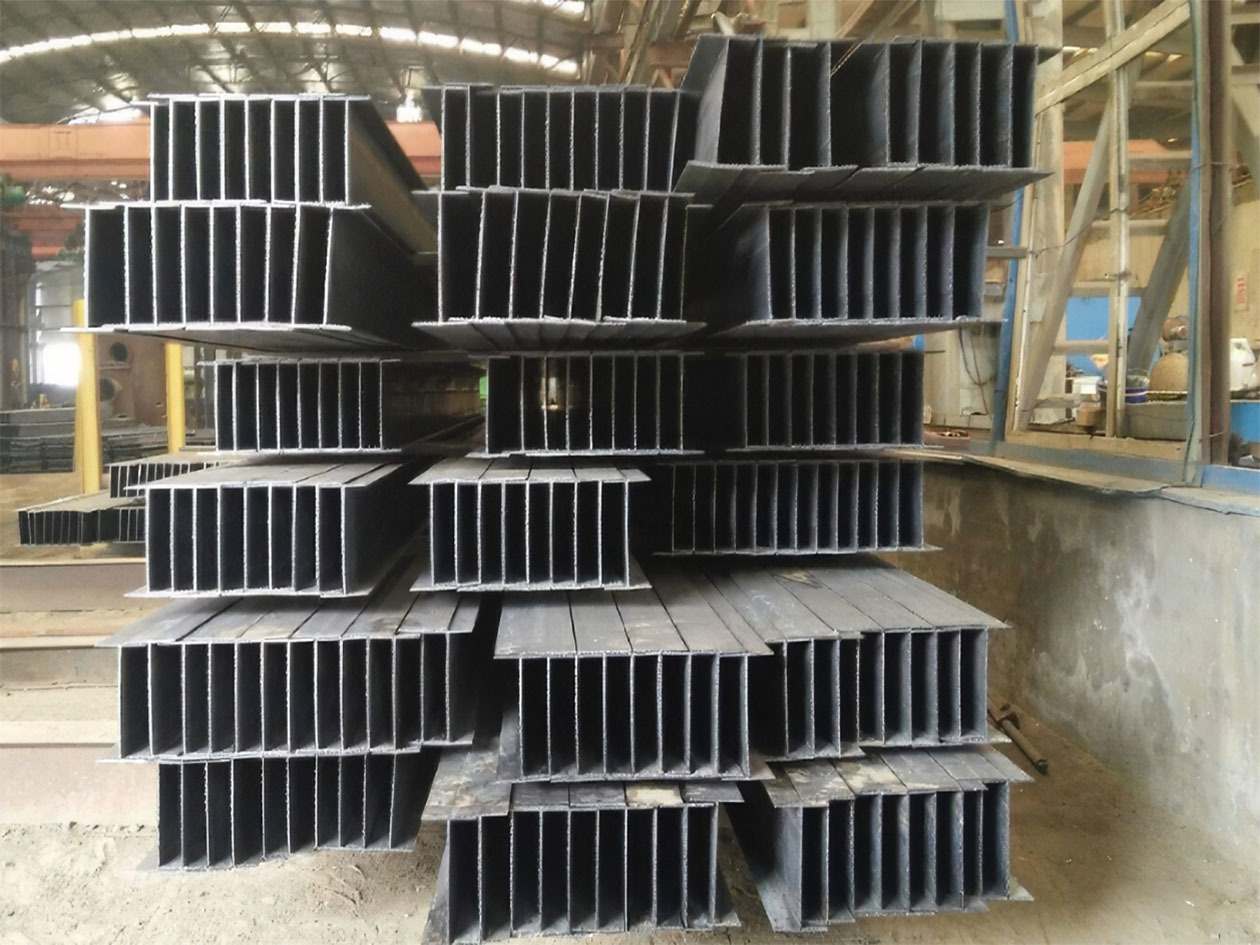



- Details
-
Overview
Hot rolled steel H-sections, also known as H-beams or wide flange beams, are structural steel profiles shaped like the letter "H." They are manufactured through a hot rolling process, where steel billets are heated above their recrystallization temperature (typically ~1,100°C) and passed through rollers to achieve the desired cross-section.Key Features
● Shape: Consists of two parallel flanges (horizontal elements) connected by a web (vertical element), forming an "H" geometry.
● Uniform Thickness: Flanges and web typically have consistent thickness, though some variants (e.g., tapered flanges) exist.
● Standardized Dimensions: Produced in compliance with international standards (e.g., ASTM A36, EN 10025, JIS G3101).
● Material and Grades:
Made from carbon steel or low-alloy steel (common grades: S235, S275, S355 in Europe; A36, A572 in the US).Hot rolling enhances mechanical properties by refining the grain structure.
Product Name Hot Rolled H-Sections Steel Size 1.Web Width (H): 100-900mm, or customized
2.Flange Width (B): 50-400mm, or customized
3. Web Thickness (t1): 5-30mm, or customized
4. Flange Thickness (t2): 5-30mm, or customizedLength 6-12m, or customized Standard JIS G3101 EN10025 ASTM A36 ASTM A572 ASTM A992 Material SS400 SS540 S235 S275 S355 A36 A572 Technique Hot rolled Application Construction structure Packing In bundle fasten by steel strip Payment TT , LC 
Material Properties
Hot rolled steel H-sections are structural profiles characterized by their high strength, ductility, and weldability, achieved through controlled carbon-manganese steel compositions and the hot rolling process. Key properties include:● Grades: Common grades include S235, S355 (EN), A36, A992 (ASTM).
● Yield Strength: Typically 235–355 MPa (varies by grade).
● Microstructure: Fine ferrite-pearlite grains from hot rolling, balancing strength and machinability.
● Corrosion Resistance: Limited; requires protective coatings (e.g., galvanizing) for harsh environments.
● Weldability & Fabrication: Excellent for most grades, though preheating may be needed for thicker/higher-carbon sections.
These properties make hot rolled H-sections ideal for construction, bridges, and industrial frameworks, combining cost-efficiency, durability, and ease of fabrication.
Manufacturing Process
Heating: Steel slabs are reheated to ~1200°C for plasticity.Rolling: Passed through a series of rollers to form the H-shape.
Cooling: Naturally air-cooled, retaining a mill scale (oxide layer) unless removed.

Advantages And Applications
Advantages Of Hot Rolled H-Sections
● High strength-to-weight ratio for load-bearing applications.
● Cost-effective compared to welded or cold-formed sections.
● Excellent weldability and machinability due to uniform microstructure.
● Wider flanges than I-beams, offering better resistance to bending and buckling.
Common Applications
● Construction: Beams, columns, and frames in buildings/bridges.
● Industrial: Support structures for machinery, platforms, and warehouses.
● Infrastructure: Railway tracks, transmission towers, and shipbuilding.
Comparison With Other Sections
vs. I-beams: H-sections have wider, thicker flanges for better load distribution.vs. Cold-Formed Steel: Hot rolled offers higher strength and durability for heavy-duty use.
Conclusion
Hot rolled H-sections are fundamental in modern steel construction due to their structural efficiency, ease of fabrication, and adaptability to diverse engineering requirements. Their standardized production ensures consistent quality for global applications.


Hot rolled steel H-sections
Subcategory
Keyword
- Details
-
Overview
Hot rolled steel H-sections, also known as H-beams or wide flange beams, are structural steel profiles shaped like the letter "H." They are manufactured through a hot rolling process, where steel billets are heated above their recrystallization temperature (typically ~1,100°C) and passed through rollers to achieve the desired cross-section.Key Features
● Shape: Consists of two parallel flanges (horizontal elements) connected by a web (vertical element), forming an "H" geometry.
● Uniform Thickness: Flanges and web typically have consistent thickness, though some variants (e.g., tapered flanges) exist.
● Standardized Dimensions: Produced in compliance with international standards (e.g., ASTM A36, EN 10025, JIS G3101).
● Material and Grades:
Made from carbon steel or low-alloy steel (common grades: S235, S275, S355 in Europe; A36, A572 in the US).Hot rolling enhances mechanical properties by refining the grain structure.
Product Name Hot Rolled H-Sections Steel Size 1.Web Width (H): 100-900mm, or customized
2.Flange Width (B): 50-400mm, or customized
3. Web Thickness (t1): 5-30mm, or customized
4. Flange Thickness (t2): 5-30mm, or customizedLength 6-12m, or customized Standard JIS G3101 EN10025 ASTM A36 ASTM A572 ASTM A992 Material SS400 SS540 S235 S275 S355 A36 A572 Technique Hot rolled Application Construction structure Packing In bundle fasten by steel strip Payment TT , LC 
Material Properties
Hot rolled steel H-sections are structural profiles characterized by their high strength, ductility, and weldability, achieved through controlled carbon-manganese steel compositions and the hot rolling process. Key properties include:● Grades: Common grades include S235, S355 (EN), A36, A992 (ASTM).
● Yield Strength: Typically 235–355 MPa (varies by grade).
● Microstructure: Fine ferrite-pearlite grains from hot rolling, balancing strength and machinability.
● Corrosion Resistance: Limited; requires protective coatings (e.g., galvanizing) for harsh environments.
● Weldability & Fabrication: Excellent for most grades, though preheating may be needed for thicker/higher-carbon sections.
These properties make hot rolled H-sections ideal for construction, bridges, and industrial frameworks, combining cost-efficiency, durability, and ease of fabrication.
Manufacturing Process
Heating: Steel slabs are reheated to ~1200°C for plasticity.Rolling: Passed through a series of rollers to form the H-shape.
Cooling: Naturally air-cooled, retaining a mill scale (oxide layer) unless removed.

Advantages And Applications
Advantages Of Hot Rolled H-Sections
● High strength-to-weight ratio for load-bearing applications.
● Cost-effective compared to welded or cold-formed sections.
● Excellent weldability and machinability due to uniform microstructure.
● Wider flanges than I-beams, offering better resistance to bending and buckling.
Common Applications
● Construction: Beams, columns, and frames in buildings/bridges.
● Industrial: Support structures for machinery, platforms, and warehouses.
● Infrastructure: Railway tracks, transmission towers, and shipbuilding.
Comparison With Other Sections
vs. I-beams: H-sections have wider, thicker flanges for better load distribution.vs. Cold-Formed Steel: Hot rolled offers higher strength and durability for heavy-duty use.
Conclusion
Hot rolled H-sections are fundamental in modern steel construction due to their structural efficiency, ease of fabrication, and adaptability to diverse engineering requirements. Their standardized production ensures consistent quality for global applications.


Related products
Product Consulting

Address: Hengtai Road,Daqiuzhuang Town,Jinghai County,Tianjin,China
Mob: +8615122229899(whatspp)
Phone: +86 22 58171905
Fax: +86 22 58171902
E-mail:info@lefinsteel.com
Get company updates

Tianjin Lefin Industrial Co.,Ltd. All rights reserved City sub-station SEO www.300.cn

